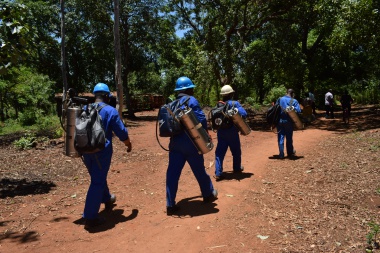
IRS with organophosphate, in addition to standard LLINs, provides additional protection against malaria transmission in Ghana, Mali, Mozambique, Zambia, and Uganda.
A summary through April 2019
Evidence from multiple countries demonstrates that IRS with new 3GIRS products is a wise public health investment, especially in areas with documented pyrethroid resistance, where house structures and population densities are appropriate, and even where net coverage is high.
Mozambique
A cluster randomised trial is underway in Mopeia District in the Zambezia Province of Mozambique, an area of high malaria endemicity(1). Evidence generated through this study will determine the incremental benefit of 3GIRS in reducing malaria incidence and at what level of cost-effectiveness. All villages in the study area have access to LLINs through mass and routine distribution campaigns, and half of the villages were randomised to receive IRS with Actellic® 300CS as well. Preliminary results from entomological monitoring and passive case reporting in 2017 show:
There was a 50% reduction in An. funestus densities in IRS villages
There were 20% fewer cases presenting at health facilities from IRS villages compared to non-IRS villages
Other project countries
Retrospective observational analyses of the impact of IRS are being supported in Zambia, Mali(2), Ghana, and Uganda. Results to date indicate that:
Mali
After introducing IRS in Mopti region in 2017, there was a 40% reduction in incidence over 4 months (~3,800 cases averted at district health facilities) in IRS communities
In Ségou region, IRS campaigns from 2012 – 2014 averted more than 300K cases over the 3 years
After removal of IRS, sharp increases in incidence were observed in both Bla (70% in 2015) and Barouéli (125% in 2017) districts
Ghana
In 2017, there were 414 fewer cases per 10,000 person-months in IRS vs. non-IRS districts in Northern Region
In 2017, IRS operations were reintroduced in the Upper East region – Kassena and Builsa districts – and case incidence rates fell by an average of 309 cases per 10,000 person months compared to 2016
Zambia
The odds of malaria infection were reduced in areas with IRS:
Non-3GIRS coverage was associated with a 9% reduction in parasite prevalence (AOR=0.91, 95% BCI 0.68-1.20)
IRS coverage with Actellic® 300CS, a 3GIRS product, was associated with a 26% reduction in parasite prevalence (AOR=0.74, 95% BCI 0.44-1.26)
Uganda
IRS with bendiocarb in 2015 (2 rounds) was associated with a 20% decrease in cases (AOR 0.8 [0.7 – 0.9])
IRS with Actellic in 2016 was associated with a 47% decrease (AOR 0.53 [0.43 – 0.66])
Further research and evaluation activities assessing the health impact and cost-effectiveness of 3GIRS are ongoing, and dissemination of final results are expected throughout 2019.
1. Chaccour, et al. 2018. BMJ Glob Health.3:e000610
2. Wagman, et al. 2018. Mal J. 17:19
Links to more news on evidence:
MIM conference, April 2018: sharing preliminary trial results





